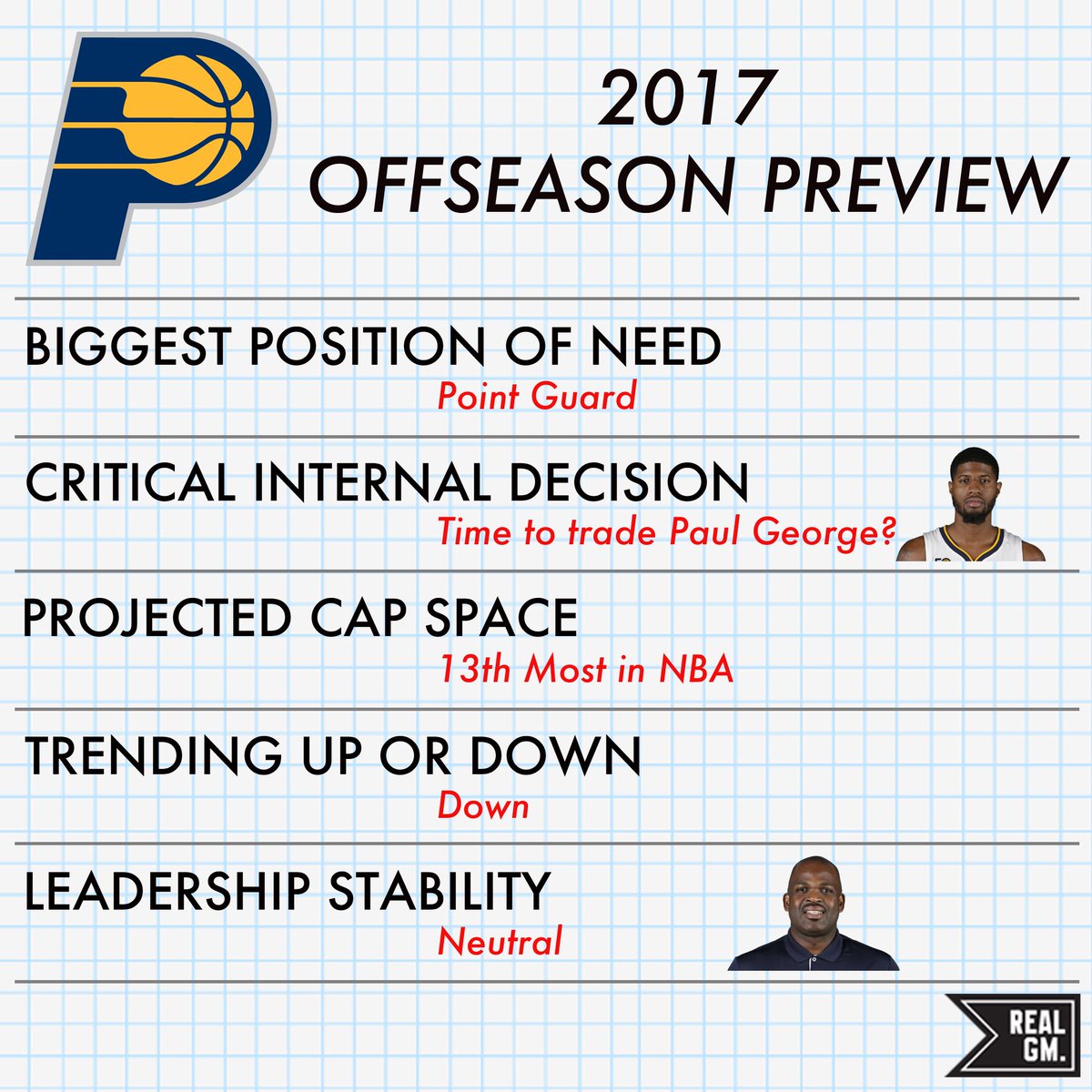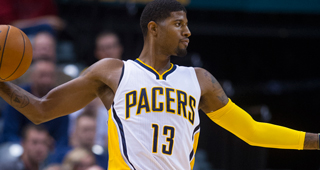While the Indiana Pacers never quite came together as hoped this season, they made the playoffs during Nate McMillan's first season after he replaced Frank Vogel as head coach. The Pacers didn’t really play at the much faster pace hoped for and it took a while for players to figure out their roles, but they managed to push the Cavaliers in four tightly contested first round games. Like last year, this offseason has the potential for significant change.
Indiana underwent substantial change not only in terms of leadership but to the roster as well. It started on draft night, when the Pacers swung a pair of deals to bring in two new starters. The first was to trade longtime starting point guard George Hill to Utah, as part of a three team trade that brought Jeff Teague from Atlanta to Indiana. The Pacers then shipped their first round draft pick (Caris LeVert) to Brooklyn for Thaddeus Young.
With Teague and Young in the fold as new starters, and Myles Turner promoted to the starting lineup to replace the departing Ian Mahinmi, Indiana sought to rebuild their bench. They added Al Jefferson to provide frontcourt scoring, and Aaron Brooks to help in the backcourt. Late in the fall, Kevin Seraphin was brought in to add some additional depth up front.
The new additions had decidedly mixed results. With Paul George and Monta Ellis, two high-volume offensive players, it took a while for the team to adjust to Teague. Teague is a point guard who needs the ball in his hands to make things happen, unlike Hill, who was comfortable playing off the ball while George and Ellis went to work. In addition, Turner and Young also needed touches up front. With only one ball to go around, it contributed to some uneven play all year long.
Once the rotation was re-worked, Teague and Young had productive seasons for Indiana. The Pacers seemed to play best with Ellis shifted to a reserve role, where he could provide some scoring against second units. The scoring off the bench was needed, with Jefferson missing 16 regular season games (and the entire playoffs) and parts of several others, with recurring injury issues. In part due to the injuries, Jefferson never really settled in.
Late in the season, right before the deadline for playoff eligibility, Indiana used a creative contract structure to waive Rodney Stuckey. Not only did this free up a roster spot for the Pacers this year, but removed the opportunity for Stuckey to opt in next season. Indiana then used their remaining cap space to bring back Lance Stephenson. Stephenson played in just six regular season games, but put together an impressive playoffs with 16 points per game. Stephenson has never played quite as well away from Indiana, so the Pacers hope they can recapture his former production.
Both Teague and Brooks are free agents this summer. With only the impressive Joseph Young remaining as a point guard option, it is imperative that the Pacers re-sign Teague. Once he figured out his role in the lineup, Teague played quite well for the Pacers. Brooks may be back as well, but it will have to come as a cheap backup option, similar to this season.
C.J. Miles has given Indiana an outside shooting weapon and has played anywhere from the 2-4 positions in recent years. He’s a great fit as an off the ball player next to George and could return to Indiana on a new deal.
Indiana has a team option on Lavoy Allen but they could let him test free agency due to their frontcourt depth. If he doesn’t get an offer to his liking, Indiana could then bring him back to fill his familiar role as a reserve big.
Of the Pacers' five non-guaranteed players, Glenn Robinson III seems to be a lock to return. In addition to coming to national prominence after winning the Slam Dunk Contest at All-Star Weekend, Robinson had his most productive season in the NBA. He became a critical part of the Indiana rotation and even started for a chunk of the year.
Seraphin, Young, Georges Niang and Rakeem Christmas are likely to have their fates tied to the Pacers need for cap space. If Indiana needs to waive any of the four to use cap space, they’ll likely be moving on. If not, all will probably attend training camp with the Pacers and fight for roster spots.
Of course, all of the above pales in comparison to the Pacers' single biggest decision this summer: is it time to trade Paul George? As the season wound down George increasingly voiced his frustration with the Pacers lack of winning and his teammates, and Indiana listened to offers for their franchise player for the first time. Boston made a hard push at the trade deadline, but ultimately a deal could not be put together.
George continued to voice his displeasure throughout the rest of the regular season and into the playoffs. He then let it be known that he would like to play for his hometown Los Angeles Lakers when he can become a free agent in 2018. In addition, with George missing out on making an All-NBA team, he is not eligible for the new Designated Player Veteran Extension (DPVE) this summer, which would have allowed the Pacers to give him a major increase in pay and might have been enough keep him.
Publicly, the Pacers have been fairly quiet, but the first task facing Kevin Pritchard is a monumental one. If Indiana hangs onto George, they risk watching him walk away in the summer of 2018 for nothing. Their major leverage point, the DPVE, is no longer in play. It is probably time for Indiana to get serious about listening to offers. Unfortunately, with George only under contract for one more season (he has a player option for 2018-19 that he is sure to decline) and his known affinity for the Lakers, his value is somewhat complicated.
On one hand, George is one of the best players in the NBA and would improve any team he goes to. That should fetch a lot in trade. On the other hand, no team is going to want to pay a major price for a player who could walk away after just one year. At this point, the Pacers need to see if they can extract a package of young players and/or draft picks from a team with an excess of both that is also on the verge of contention. The Celtics seem to fit this bill and had interest at the trade deadline. Depending on how the rest of the Boston offseason goes, it would behoove Indiana to at least be open to having a conversation.
The Pacers can also keep George and reassess if necessary as the season goes along, but that is a risky strategy. He could then be viewed as only a few months long rental and might not return as much of a package as he could in the offseason. They can also hope he makes All-NBA in 2018 and that re-opens the possibility of the DPVE for Indiana. That is no less risky of a strategy as his path to All-NBA is likely to be just as difficult this coming season as it was in 16-17.
The Pacers are undergoing a transition at the very top with Pritchard replacing Larry Bird. His first major decision isn’t an easy one. How he handles George could set the franchise path for years going forward. If George is traded, is there a need to re-sign Teague? Is it best to trade the other veterans and build around a blossoming young player in Turner? This summer is a bit like a Choose Your Own Adventure book for Indiana and, just like in those books, they must choose wisely.
Offseason Details
Guaranteed Contracts (6): Monta Ellis, Paul George, Al Jefferson, Lance Stephenson, Myles Turner, Thaddeus Young
Partial/Non-Guaranteed Contracts (5): Rakeem Christmas, Georges Niang, Glenn Robinson III, Kevin Seraphin, Joseph Young
Potential Free Agents (4): Lavoy Allen (UFA – Team Option), Aaron Brooks (UFA), C.J. Miles (UFA – Player Option), Jeff Teague (UFA)
“Dead” Money on Cap (0): None
First Round Draft Pick(s): Pick #18
Maximum Cap Space: $33,704,263
Projected Cap Space: $11,765,754




